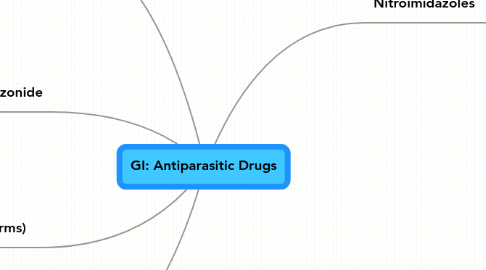
1. Iodoquinol
1.1. MOA unknown
1.1.1. Contains iodine!!
1.2. PK
1.2.1. poor oral bioavailability
1.2.1.1. Lumenicidal only!!!
1.3. SE
1.3.1. Anorexia, NVD, abdominal cramps, pruritis ani (itchy ass!)
1.3.2. Iodine toxicity (fever, itching, dermatitis)
1.3.3. Thyroid problems
1.3.4. Subacute myelo-optic neuropathy (SMON)
1.3.4.1. Occurs at high dose; kids more susceptible
2. Paromomycin
2.1. MOA
2.1.1. An aminoglycoside!
2.1.1.1. Antiparasitic properties unknown
2.2. Use
2.2.1. Lumenicidal only!
2.2.2. Use in combo with tissuecidal agent for full coverage
2.2.3. Alternative for Giardia
2.3. SE
2.3.1. Kidney and eye tox
2.3.2. All the SE of aminoglycosides
2.3.2.1. Few effects when used orally
3. Nitazonide
3.1. MOA
3.1.1. Unknown
3.1.1.1. Interferes w/ pyruvate-ferrredoxin oxidoreductase (PROR) but no DNA mutations
3.2. Use
3.2.1. DOC: Giardia, Cryptosporidium
3.2.2. Anaerobic infxns only (PFOR)
3.3. New node
4. Anthelmintics (anti-worms)
4.1. Benzimidazoles (BZAs)
4.1.1. Thiabendazole
4.1.1.1. SE
4.1.1.1.1. Smells like asparagus
4.1.2. Mebendazole
4.1.3. Albendazole
5. Nitroimidazoles
5.1. Metronidazole
5.1.1. MOA
5.1.1.1. Prodrug oxidizes ferredoxin and NADPH; reduced form disrupts DNA's helical structure
5.1.2. Use
5.1.2.1. Selectively toxic agains anaerobic and microaerophilic pathogens
5.1.2.1.1. Entamoeba histolytica
5.1.2.1.2. Giardia
5.1.2.1.3. Trichomonas vaginalis
5.2. Tinidazole
5.2.1. SE better tolerated
5.3. Admin
5.3.1. Oral (good oral bioavailability)
5.4. Use
5.4.1. Good for intestinal ulcers and systemic effects; doesn't make it to L. intestine!
5.4.1.1. Mostly tissuecidal
5.4.2. Not for asymptomatic Amebiasis (lumenal E. histolytica)
5.4.3. All forms of Giardia, Trich. vaginalis (DOC)
5.5. SE
5.5.1. Common
5.5.1.1. Nausea
5.5.1.2. Metallic taste
5.5.1.3. Headache
5.5.2. Infrequent
5.5.2.1. Vomiting
5.5.2.2. vertigo
5.5.2.3. insomnia
5.5.2.4. dizziness
5.5.2.5. Neuropathy - ataxia, seizures, encephalopathy (rare)
5.5.3. Disulfram-like rxn
5.5.4. Teratrogenic
5.5.5. Red-brown urine
